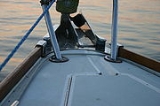
Jackline
Encyclopedia

Ship
Since the end of the age of sail a ship has been any large buoyant marine vessel. Ships are generally distinguished from boats based on size and cargo or passenger capacity. Ships are used on lakes, seas, and rivers for a variety of activities, such as the transport of people or goods, fishing,...
's bow
Bow (ship)
The bow is a nautical term that refers to the forward part of the hull of a ship or boat, the point that is most forward when the vessel is underway. Both of the adjectives fore and forward mean towards the bow...
to stern
Stern
The stern is the rear or aft-most part of a ship or boat, technically defined as the area built up over the sternpost, extending upwards from the counter rail to the taffrail. The stern lies opposite of the bow, the foremost part of a ship. Originally, the term only referred to the aft port section...
to which a safety harness can be clipped, allowing a crewmember to move about the deck
Deck (ship)
A deck is a permanent covering over a compartment or a hull of a ship. On a boat or ship, the primary deck is the horizontal structure which forms the 'roof' for the hull, which both strengthens the hull and serves as the primary working surface...
safely when there is risk of falling or being swept overboard. At sea, falling overboard
Man overboard
Man overboard is a situation in which a person has fallen from a boat or ship into the water and is in need of rescue. Whoever sees the person's fall should shout "man overboard" to alert other crew members and attempt to maintain visual contact with the person in the water...
is one of the leading causes of death
Death
Death is the permanent termination of the biological functions that sustain a living organism. Phenomena which commonly bring about death include old age, predation, malnutrition, disease, and accidents or trauma resulting in terminal injury....
in boating
Boating
Boating is the leisurely activity of travelling by boat, or the recreational use of a boat whether powerboats, sailboats, or man-powered vessels , focused on the travel itself, as well as sports activities, such as fishing or water skiing...
; fastening oneself to the ship with a safety harness reduces this risk.
Generally the jacklines are run from the bow
Bow (ship)
The bow is a nautical term that refers to the forward part of the hull of a ship or boat, the point that is most forward when the vessel is underway. Both of the adjectives fore and forward mean towards the bow...
to the stern
Stern
The stern is the rear or aft-most part of a ship or boat, technically defined as the area built up over the sternpost, extending upwards from the counter rail to the taffrail. The stern lies opposite of the bow, the foremost part of a ship. Originally, the term only referred to the aft port section...
on both starboard and the port side of a ship
Ship
Since the end of the age of sail a ship has been any large buoyant marine vessel. Ships are generally distinguished from boats based on size and cargo or passenger capacity. Ships are used on lakes, seas, and rivers for a variety of activities, such as the transport of people or goods, fishing,...
. Jack lines are used in heavy weather and in periods of reduced visibility
Visibility
In meteorology, visibility is a measure of the distance at which an object or light can be clearly discerned. It is reported within surface weather observations and METAR code either in meters or statute miles, depending upon the country. Visibility affects all forms of traffic: roads, sailing...
, i.e. fog or at night.
Jacklines may be rigged temporarily when bad weather is expected, or, especially on sailboat
Sailboat
A sailboat or sailing boat is a boat propelled partly or entirely by sails. The term covers a variety of boats, larger than small vessels such as sailboards and smaller than sailing ships, but distinctions in the size are not strictly defined and what constitutes a sailing ship, sailboat, or a...
s heading offshore, they may be left in place all the time and used as necessary. They are usually attached to strong padeye
Padeye
A padeye is a device often found on boats that a line runs through, or provides an attachment point. It is a kind of fairlead and often is bolted or welded to the deck or hull of a boat....
or cleat
Cleat (nautical)
In nautical contexts, a cleat is a device for securing a rope. The traditional design is attached to a flat surface or a spar and features two “horns” extending parallel to the deck or the axis of the spar, resembling an anvil....
fittings at both ends of the boat, allowing the crewmember to move fore and aft by sliding their harness' clip along the line. Jacklines may be made of wire
Wire
A wire is a single, usually cylindrical, flexible strand or rod of metal. Wires are used to bear mechanical loads and to carry electricity and telecommunications signals. Wire is commonly formed by drawing the metal through a hole in a die or draw plate. Standard sizes are determined by various...
or low-stretch rope
Rope
A rope is a length of fibres, twisted or braided together to improve strength for pulling and connecting. It has tensile strength but is too flexible to provide compressive strength...
. More recently, sailors are using high strength nylon webbing. The reason is that flat webbing does not roll under foot while working on deck. This reduces the hazard that can be created by using rope. The image to the right shows the traditional steel wire jackline and the image below shows an example of a more modern jackline made of flat nylon webbing.


